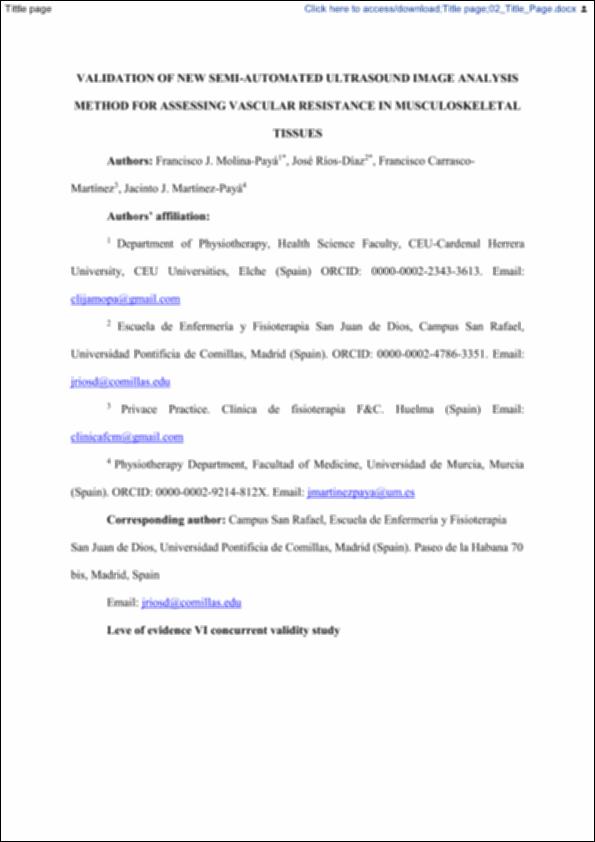Por favor, use este identificador para citar o enlazar este ítem:
http://hdl.handle.net/10637/14943Validation of new semi-automated ultrasound image analysis method for assessing vascular resistance in musculoskeletal tissues
| Título : | Validation of new semi-automated ultrasound image analysis method for assessing vascular resistance in musculoskeletal tissues |
| Autor : | Molina Payá, Francisco Javier Ríos Díaz, José Carrasco Martínez, Francisco Martínez Payá, Jacinto J. |
| Materias: | Terapia; Therapy; Fisioterapia; Physical therapy; Ultrasonidos; Ultrasonics; Sistema musculoesquelético; Musculoskeletal system |
| Editorial : | Edra |
| Citación : | Molina-Payá, F.J., Ríos-Díaz, J., Carrasco-Martínez, F. & Martínez-Payá, J.J. (2023). Validation of new semi-automated ultrasound image analysis method for assessing vascular resistance in musculoskeletal tissues. M.L.T.J. Muscles, Ligaments and Tendons Journal, vol. 13, i. 1 (jan.-mar.), pp. 24-30. DOI: https://doi.org/10.32098/mltj.01.2023.04 |
| Resumen : | Objective: The aim of this study was to analyze the concurrent validation between the resistance index (RI) obtained by Spectral Doppler (SD) and the vascular resistance (VR) calculated by quantifying pixel color intensity of the power Doppler (PD) signal. Methods: The brachial artery of 30 healthy participants (24.8 yrs; SD = 6.44 yrs) were evaluated with systolic and diastolic peaks. Three assessments were performed on each participant, obtaining a total of 90 ultrasound assessments of the brachial artery with their respective RI. Processing and analysis were performed ImageJ software were manually selected and extracted from the brachial artery PD images with the highest and lowest signal corresponding to peak systolic and end diastole for each patient. The mean pixel color of the image with the highest signal was considered as the peak systolic velocity and of the image with the lowest signal as the end-diastolic velocity. Results: A high correlation was found between RI and VR (r=.92; 95%CI= .88 to .95; p there is a very strong concurrent validity between the two measures, and they can be considered equivalents (common variability of 84%). Conclusion: This new method of analyzing DS by quantifying the color intensity of the PD signal pixel is a good predictor of RI and could be useful for VR analysis in musculoskeletal tissues where measurement of RI is complicated such in neovascularization in tendinopathies with multiple Doppler signals. |
| Descripción : | NOTICE: this is the author’s version of a work that was accepted for publication in "MLTJ - Muscle, Ligaments and Tendons Journal". Changes resulting from the publishing process, such as peer review, editing, corrections, structural formatting, and other quality control mechanisms may not be reflected in this document. Changes may have been made to this work since it was submitted for publication. A definitive version was subsequently published in "MLTJ - Muscle, Ligaments and Tendons Journal", vol. 13, i. 1 (jan.-mar.). DOI: https://doi.org/10.32098/mltj.01.2023.04 |
| URI : | http://hdl.handle.net/10637/14943 |
| Derechos: | http://creativecommons.org/licenses/by-nc-nd/4.0/deed.es |
| ISSN : | 2240-4554 |
| Fecha de publicación : | ene-2023 |
| Centro : | Universidad Cardenal Herrera-CEU |
| Aparece en las colecciones: | Dpto. Enfermería y Fisioterapia |
Los ítems de DSpace están protegidos por copyright, con todos los derechos reservados, a menos que se indique lo contrario.


